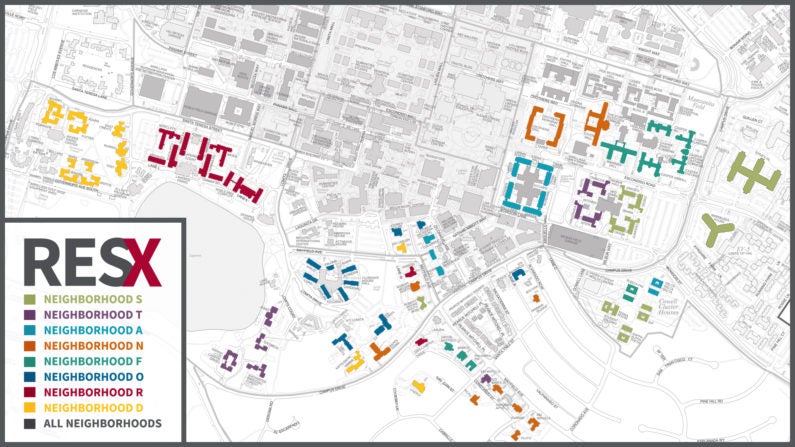Undergraduate housing neighborhoods announced
New neighborhoods created out of existing student housing support lasting friendships and community for students throughout their time at Stanford.
Undergraduate students recently learned which existing housing will be grouped into the newly designed residential neighborhoods that will provide a social and intellectual home during their time at Stanford. These neighborhoods are part of the ResX initiative that arose out of the Long-Range Vision’s increased focus on community and civic engagement.
In designing the neighborhoods, Residential & Dining Enterprises (R&DE), Land, Buildings & Real Estate (LBRE) and Residential Education along with student and alumni advisory boards prioritized all-frosh housing in every neighborhood, plus all-soph housing in every neighborhood for the 21-22 academic year. These dorms provide students in their first year on campus a chance to meet classmates and create lasting friend groups.
“Many students communicated the desire to develop relationships and experience a sense of community in their frosh year, and have the opportunity to learn and grow in that same community during their undergraduate years at Stanford,” said Shirley J. Everett, senior associate vice provost for R&DE. “To support that vision, we have designed the neighborhoods so that each offers a broad spectrum of options – dormitories, theme houses, coops, self-ops, Greek houses, apartments and accommodations for students with disabilities.”
The group is seeking community input for neighborhood names. In the interim, the neighborhoods are named S, T, A, N, F, O, R and D.

New undergraduate neighborhoods create a social and intellectual home for students during their time at Stanford. (Click on image to enlarge.) (Image credit: Courtesy ResX)
When the assignment portal opens, students will rank their neighborhood preferences as individuals or in groups of up to eight students as a way of keeping friend groups intact. They will learn their neighborhood assignments in late May. In June, students will be invited to rank the housing options within their neighborhood and they will learn those assignments in late July. Then, in August, students will pick individual rooms within their assigned residences.
Upper-class students can leave their neighborhoods to live in a university-wide theme house, including an ethnic theme dorm, academic, coop or Greek house, anywhere on campus for two of their three years – called a neighborhood abroad year.
The new neighborhoods also include a flexible meal program that allows students the opportunity to eat across the campus and deepen friendships, regardless of their housing assignment. Students will pay the same meal plan cost, whether they live in a house with a dining hall or in more independent housing – a substantial reduction in meal plan costs compared with previous years for some independent housing options.
Students involved in the process advocated for access to meals across neighborhoods as important opportunities to engage with each other, with faculty and with members of the Stanford community. The neighborhood meal plans are aligned with the core principles of ResX to advance diversity, equity and inclusion; to promote opportunities for community and belonging, and to support student health and well-being.
“We have created a new neighborhood assignment process to assist students in building connections within their neighborhoods while providing housing options that allow them to explore a variety of choices during their time at Stanford,” Everett said. “Students will receive an email from R&DE on April 9 with information and instructions on how to apply and a link to our new website that includes maps to help them become familiar with the neighborhoods and the housing and dining options in each.”
When students arrive at their new neighborhoods in the fall, the inaugural neighborhood residents will begin designing the cultures that will permeate and define each neighborhood for future students, including swag and themes, and students will work to create inclusive cultures that embrace diversity.
